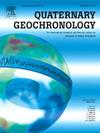基于预剂量MET-pIRIR协议的k长石单粒发光定年
IF 2.5
2区 地球科学
Q3 GEOGRAPHY, PHYSICAL
引用次数: 0
摘要
富钾长石(k -长石)由于其高饱和剂量而被广泛用于发光测年,可以确定较老沉积物的年龄。先前的研究表明,后红外红外激发发光(pIRIR)信号的“灵敏度”可以保留接收前剂量的“记忆”,但可以通过阳光漂白来重置。在多等分和单等分预剂量多升温后红外红外光谱分析(pMET-pIRIR)方法的基础上,研究了单等分再生剂量(SAR) pMET-pIRIR方法在k长石单粒水平上的性能。太阳漂白实验表明,在每个再生周期后进行3 h的太阳模拟器漂白步骤,可以有效地重置IRSL和MET-pIRIR信号的灵敏度。将SAR pMET-pIRIR方法与基于标准化生长曲线(SGC)的LnTn方法相结合,成功地克服了灵敏度的携带,减轻了异常衰落,扩大了k长石发光定年的范围,提高了测量效率。等效剂量(De)可以使用灵敏度校正信号(Lx/Tx)、再生信号(Lx)和试验剂量信号(Tx)来确定,在不同剂量范围内提供灵活性,并通过交叉验证提高测年可靠性。对来自中国的三个沉积物样品的应用,包括具有独立已知年龄的样品,证实了该方法能够获得高达~ 1600 Gy (~ 440 ka)的精确De值,并有可能使用Lx和Tx信号对接近~ 1 Ma的样品进行测年。单粒SAR pMET-pIRIR方法提供了一种很有前途的方法来测定更古老的沉积物的年代,并研究颗粒之间或沉积后扰动沉积物的非均质发光行为。本文章由计算机程序翻译,如有差异,请以英文原文为准。
Single-grain luminescence dating of K-feldspar based on the pre-dose MET-pIRIR protocol
Potassium-rich feldspar (K-feldspar) is widely used in luminescence dating due to its high saturation dose, allowing the determination of ages for older sediments. Previous studies have shown that the ‘sensitivity’ of the post-infrared infrared stimulated luminescence (pIRIR) signal can retain a ‘memory’ of the pre-dose received but can be reset by sunlight bleaching. Building on the development of multi-aliquot and single-aliquot pre-dose multi-elevated-temperature post-IR IRSL (pMET-pIRIR) procedures, we investigate the performance of the single-aliquot regenerative-dose (SAR) pMET-pIRIR procedure for K-feldspar at the single-grain level. Solar bleaching experiments demonstrate that the sensitivity of the IRSL and MET-pIRIR signals can be effectively reset by a 3 h solar simulator bleaching step applied after each regenerative cycle. Integrating the SAR pMET-pIRIR procedure with the standardised growth curve (SGC)-based LnTn method successfully overcomes sensitivity carry-over, mitigates anomalous fading, extends the dating range and improves measurement efficiency for K-feldspar luminescence dating. Equivalent doses (De) can be determined using the sensitivity-corrected signal (Lx/Tx), regenerative signal (Lx) and test dose signal (Tx), providing flexibility across different dose ranges and improving dating reliability through cross-validation. Application to three sediment samples from China, including samples with independent known ages, confirms the method's ability to obtain accurate De values up to ∼1600 Gy (∼440 ka), with the potential to date samples approaching ∼1 Ma using the Lx and Tx signals. The single-grain SAR pMET-pIRIR method offers a promising approach for dating older sediments and investigating heterogeneous luminescence behaviours among grains or post-depositionally disturbed deposits.
求助全文
通过发布文献求助,成功后即可免费获取论文全文。
去求助
来源期刊

Quaternary Geochronology
地学-地球化学与地球物理
CiteScore
4.40
自引率
22.20%
发文量
130
审稿时长
20 weeks
期刊介绍:
Quaternary Geochronology is an international journal devoted to the publication of the highest-quality, peer-reviewed articles on all aspects of dating methods applicable to the Quaternary Period - the last 2.6 million years of Earth history. Reliable ages are fundamental to place changes in climates, landscapes, flora and fauna - including the evolution and ecological impact of humans - in their correct temporal sequence, and to understand the tempo and mode of geological and biological processes.
 求助内容:
求助内容: 应助结果提醒方式:
应助结果提醒方式:


